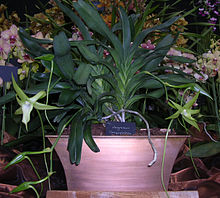Angraecum
| Angraecum | |
|---|---|
 |
|
|
Angraecum sesquipedale habitus Note extremely long spurs of flowers |
|
| Scientific classification | |
| Kingdom: | Plantae |
| (unranked): | Angiosperms |
| (unranked): | Monocots |
| Order: | Asparagales |
| Family: | Orchidaceae |
| Subfamily: | Epidendroideae |
| Tribe: | Vandeae |
| Subtribe: | Angraecinae |
| Alliance: | Angraecum |
| Genus: |
Angraecum Bory, 1804 |
| Selected Species | |
See List of Angraecum species for complete list. |
|
| Synonyms | |
|
|
See List of Angraecum species for complete list.
The genus Angraecum, abbreviated as Angcm in horticultural trade, common name Angrek (Indonesian and Malay) or Comet Orchid, contains about 220 species.
They are quite varied vegetatively and florally and are adapted to dry tropical woodland habitat and have quite fleshy leaves as a consequence. Most are epiphytes, but a few are lithophytes.
The long-lasting flowers are racemose and grow from the leaf axils. They are mostly white, but a few are yellow, green or ochre. They all have a long spur at the back of the labellum (lip).
In the case of Angraecum sesquipedale, a species from Madagascar, on observing the 30 cm spur in the lip, Charles Darwin made the hypothesis that, since the nectar was at the bottom of the spur, a pollinator must exist with a tongue at least that long. Otherwise the orchid could never be pollinated. At the time, he was not believed. However, in 1903, the predicted pollinator was discovered, a hawk moth then named Xanthopan morganii praedicta ("praedicta" meaning "the predicted one"). It has an appropriately long proboscis. The specific name sesquipedale means "one foot and a half", referring to the length of the spur. This is a perfect example of mutual dependence of an orchid and a specific pollinator.
Tropical Africa and Madagascar contain the majority of the genus with one outlier found on Sri Lanka, and three species once thought to belong to the genus in Japan and the Philippines. But these orchids can also be found on the Comoros, the Seychelles, and the Mascarenes. They occur between sea level and 2,000m in humid regions.
...
Wikipedia
